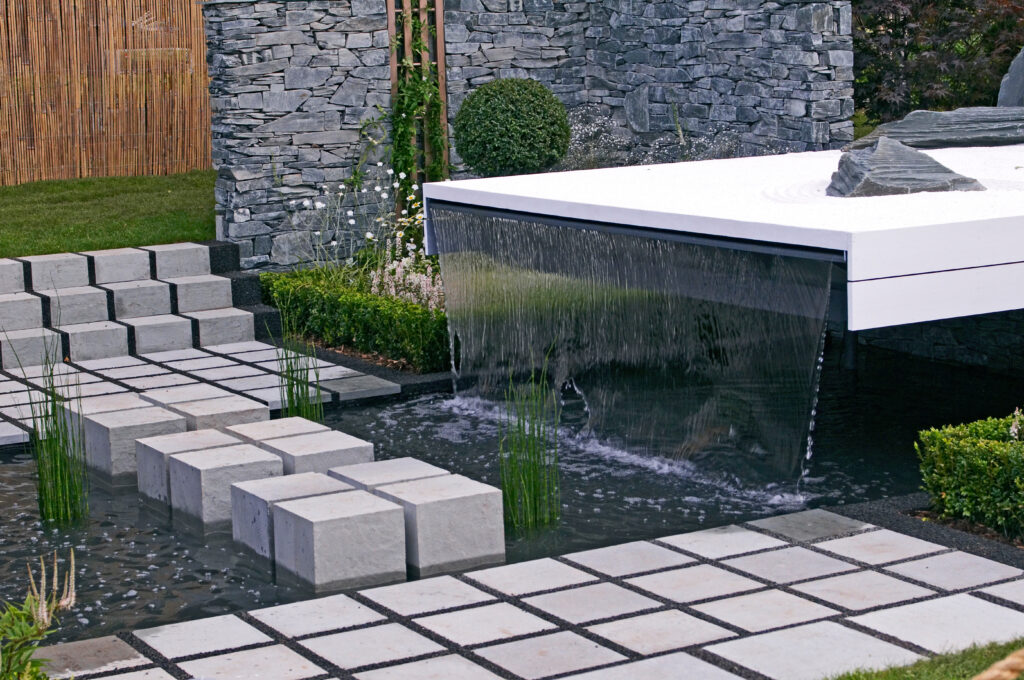Is there anything more soothing than the gentle sound of water flowing in your backyard? If you’re ready to transform your outdoor space into a calming oasis, look no further than water features. From tranquil ponds to mesmerizing waterfalls and elegant fountains, these aquatic additions can elevate any landscape to a whole new level of serenity. In this blog post, we’ll dive into the world of water features, exploring construction techniques, materials, and maintenance tips to help you create your very own backyard retreat. So, grab your rubber boots and let’s make a splash!
Water Features By The Number.
- Choose Your Water Feature
Before diving into construction, you’ll need to decide which type of water feature best suits your outdoor space and personal style. Ponds offer a peaceful, natural ambiance and can even support aquatic life like fish and plants. Waterfalls provide a stunning focal point and can be designed to blend seamlessly with your existing landscape. Fountains add a touch of elegance and can be found in a wide variety of styles, from classic tiered designs to modern, minimalist options.
- Plan Your Space
Once you’ve chosen your water feature, it’s time to plan your space. Consider factors like the size of your yard, the proximity to your home, and the surrounding landscape when selecting the location for your new aquatic addition. Keep in mind that you’ll also need access to electricity and water sources for most water features.
- Select Materials
The materials you choose for your water feature will not only impact its appearance but also its longevity and maintenance requirements. Natural stone, such as granite or slate, offers a classic, timeless look and is incredibly durable. Concrete and cast stone are more affordable options that can be molded into various shapes and finishes. For a more modern aesthetic, consider using stainless steel or glass.
What Else to Consider
- Master Construction Techniques
Building a water feature requires a bit of know-how and patience. For ponds, you’ll need to excavate the area, install a pond liner, and add a filtration system and water pump. Waterfalls typically involve building a structure with a spillway or cascade, while fountains require a water basin, pump, and appropriate plumbing. If you’re new to water feature construction, consider enlisting the help of a landscape professional or taking a DIY workshop to ensure a successful project.
- Plant Selection
Incorporating plants into your water feature can add a lush, natural touch to your outdoor space. Aquatic plants, like water lilies and lotus, thrive in ponds and provide shade and shelter for fish. Marginal plants, such as irises or rushes, can be planted along the edges of ponds and waterfalls to soften the transition between water and land. Be sure to choose plants that are suitable for your climate and water conditions.
- Maintain Your Oasis
Regular maintenance is essential for keeping your water feature looking and functioning its best. This includes cleaning filters, removing debris, and monitoring water levels. For ponds, you may need to occasionally treat the water to maintain a healthy ecosystem for fish and plants. If you live in an area with freezing temperatures, be sure to winterize your water feature by draining or covering it to prevent damage.
Conclusion:
Adding a water feature to your outdoor space can instantly transform it into a serene sanctuary where you can unwind and reconnect with nature. With careful planning, the right materials, and a bit of elbow grease, you can create a beautiful and functional water feature that will enhance your landscape for years to come. So, why not dive into the world of water features and make a splash in your backyard today?
I write here about Landscape Construction – Design – and generally ramble on about whatever is on my mind.



